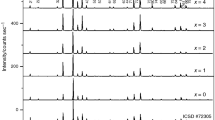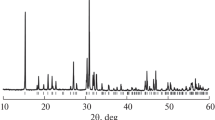Abstract
This paper reports measurements of electrical conductivity (σ) and Seebeck coefficient (S) between 300 and 1250 K and differential thermal analysis (DTA) and thermogravimetric analysis (TGA) between 300 and 1200 K, together with X-ray diffraction studies of heavy rare-earth vanadates (RVO4 with R=Tb, Dy, Ho, Er and Yb). All these vanadates have been found to have a tetragonal unit cell. The DTA study shows a flat dip in the temperature interval 1075 to 1300 K, indicating a possible structural phase transition of these compounds. Practically no weight loss has been observed in TGA from 300 to 1200 K in any of the vanadates. All RVO4 are semiconducting materials with the room-temperatureσ value lying in the range 10−12 to 10−3 Ω−1 m−1, becoming of the order of 10−2 Ω−1 m−1 around 1000 K. The electrical conductivity of all vanadates exhibits an exponential increase in the temperature intervals 420 K toT 1 andT 1 toT 2, with different values of the activation energy. A logσ againstT −1 plot shows a peak aroundT 3 and drops to a minimum value aroundT 4, before increasing again with temperature.T 4 >T 3 >T 2 >T 1 are different for different vanadates and these are termed “break temperatures”.T 4 lies well within the temperature range of the DTA peak and can be termed the phase transition temperature. In the lower temperature interval the electrical conduction is essentially extrinsic. The localized charge carriers on defect centres conduct by a hopping mechanism. The defect centres are V4+ ions in all vanadates with R4+ centres in some of them. It is concluded that in the temperature intervalT 1 <T <T 2 the conduction mechanism is of the intrinsic band type, with oxygen 2p and vanadium 3d as the valence and conduction bands, respectively. Related parameters like the energy band gap and the mobilities of the charge carriers have also been evaluated. The low values of mobility suggest that large polarons with intermediate coupling are the charge carriers rather than bare electrons in the intrinsic region. All these vanadates tend to become metallic, but before this is achieved the phase change makes the conductivity smaller.
Similar content being viewed by others
References
G. A. Gehring andK. A. Gehring,Rep. Prog. Phys. 38 (1975) 1.
Kanchan Gaur, A. K. Tripathi andH. B. Lal,J. Mater. Sci. Lett. 2 (1983) 161.
Idem, ibid. 2 (1983) 371.
Kanchan Gaur andH. B. Lal,ibid. 2 (1983) 744.
Idem, J. Mater. Sci. 19 (1984) 3325.
Idem, ibid., J. Mater. Sci. 20 (1985) 3167.
R. W. G. Wyckoff,Cryst. Struct. 3 (1965) 17.
A. K. Tripathi, PhD thesis, Gorakhpur University (1981).
A. K. Tripathi andH. B. Lal,J. Mater. Sci. 17 (1982) 1595.
H. B. Lal, B. K. Verma andV. R. Yadav,ibid. 17 (1982) 3317.
Kanchan Gaur, PhD thesis, University of Gorakhpur (1984).
R. Kumar,Science Reporter 8 (1971) 568.
G. G. Roberts, “Transfer and storage of energy in molecules”, edited by G. M. Burnett, A. N. North and J. N. Sherwood, Vol. 4 (Wiley, London, 1974) p. 153.
N. F. Mott, “Metal-Insulator Transitions” (Taylor and Francis, London, 1974) p. 160.
A. Kumar, PhD thesis, University of Gorakhpur (1975).
H. B. Lal, B. K. Verma andN. Dar,Indian J. Cryo. 1 (1976) 119.
G. B. Goodenough,J. Appl. Phys. 37 (1966) 1415.
T. C. Herman andJ. M. Honig, “Thermoelectric and thermomagnetic effects and applications” (McGraw-Hill, New York, 1967) p. 142.
J. Appel,Solid State Phys. 21 (1968) 193.
I. G. Austin andN. F. Mott,Adv. Phys. 18 (1969) 41.
A. J. Bosman andH. J. Van Daal,ibid. 19 (1970) 1.
V. S. Stubican andR. Roy,Z. Kristallogr. 119 (1963) 90.
R. R. Heikes andR. W. Urs (editors), “Thermoelectricity, Science and Engineering” (Interscience, New York, 1961). 45.
Author information
Authors and Affiliations
Rights and permissions
About this article
Cite this article
Gaur, K., Lal, H.B. Electrical transport in heavy rare-earth vanadates. J Mater Sci 21, 2289–2296 (1986). https://doi.org/10.1007/BF01114270
Received:
Accepted:
Issue Date:
DOI: https://doi.org/10.1007/BF01114270




